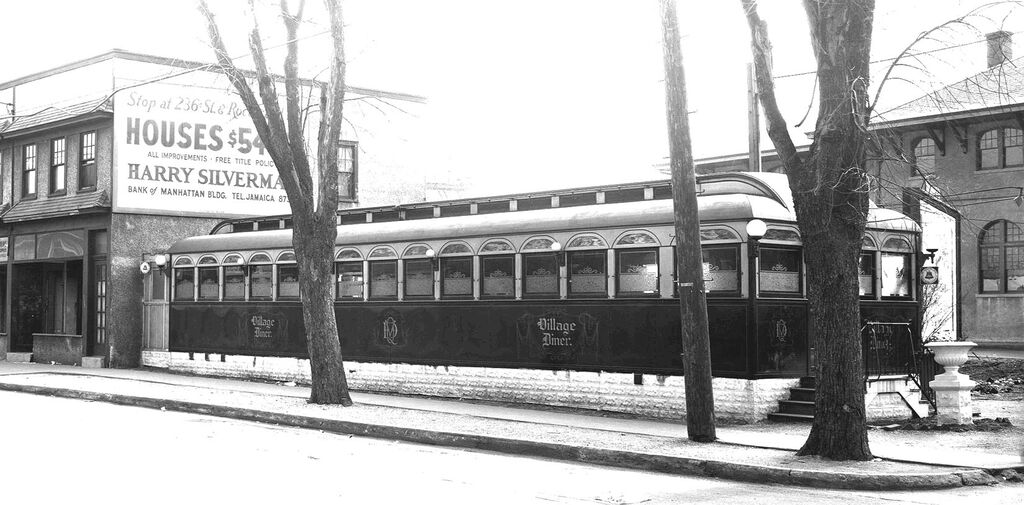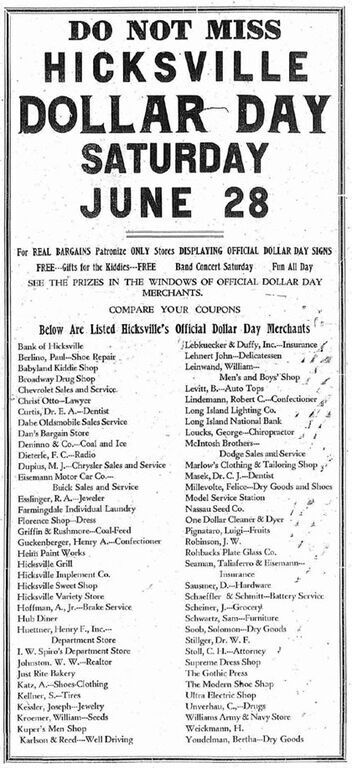 Introduction
Introduction
When the Hixnews team decided to write about “diner memories,” I volunteered to do an Ancient Hixtory article about Hicksville’s early diners. I limited myself to true diners: coffee shops, luncheonettes, ice cream parlors, Howard Johnson’s restaurants, etc. were beyond my scope. My research yield was sparse (evidently, diners were not considered inherently fascinating back then), but I did conclude that the Hub Diner was Hicksville’s first. In addition, my research shone light on a Hicksville-boosting PR campaign of a century ago – a campaign into which the Hub’s name dovetails perfectly.
Background: What's a Diner?
For many, the word “diner” evokes waffles, sticky tables, and a shiny stainless steel exterior. Yet the original diners – called “dining cars” way back when -- were not shiny at all. Converted from obsolete trolleys or railroad cars, and built of wood and ordinary steel, they were thick with paint but thin on glitz. But the public grew fond of them anyway, and manufacturers (especially ones that built streetcars) soon began selling new prefabricated diners, faux versions of the rail vehicles they made.
 Village Diner, Jamaica, New York, 1930
Village Diner, Jamaica, New York, 1930
Digital Collection of New York City Municipal ArchiveThis is an early pre-fab – the Village Diner on Springfield Blvd. in Jamaica, Queens. It was built by Brill, then the world’s largest manufacturer of streetcars. It may have evoked the aura of railroads, but it was too wide to ever have ridden the rails.
If you wanted to start your own business, it was cheaper to put a diner on an empty lot than to carve restaurant space out of an old building in your town. You laid a concrete block foundation, had your diner delivered, connected it to utilities, and started frying bacon and refilling syrup pitchers. If later you decided that the location wasn’t right for you, you could find another empty lot, hire a mover to transport your diner, and try again.
 1930 Souvenir Postcard of Pioneer Zephyr
1930 Souvenir Postcard of Pioneer Zephyr
Wikipedia.comStainless steel trains and diners were not feasible until engineers devised a process for welding together stainless and structural steel, which happened in the early 1930s. Thus, in 1934 the first stainless steel train entered service, and launched “streamlining” as a new aesthetic. Stainless steel diners followed, and the public loved them, too. Eating in a shiny metal diner let you imagine you were getting a taste (albeit a sticky one) of the future.
Earliest Print References to Hicksville Diners
The Hub Diner was first mentioned in the Long-Islander newspaper in mid-1930, earlier than I have found a reference to any other local diner. Later in the decade, the paper mentions the Fleetwood, which apparently stood somewhere on North Broadway. In addition, there is a mysterious reference to the Hicksville FD’s putting out a small fire at “Ella’s diner.” This might refer to any local eatery, including the Hub – which, I believe, was established in the latter 1920s.
Hubba-Hubba?
 Advertisement for
Advertisement for
Hicksville Dollar Day event
Huntington Long-Islander
June 27, 1930
FultonHistory.comIn 1926, a group of businessmen launched a PR campaign that tried to get people in the region to think of Hicksville as The Hub. This idea must have some about when someone finally understood the blatantly obvious: Hicksville is equidistant from Long Island’s two shores, and what with the roads and the railroad tracks, goods can be shipped between Hicksville and almost anywhere else.
Unfettered, this simplistic vision can skew your thinking until you see Hicksville as the center of the world: everything emanates from, or leads to, Hicksville. It’s the hub around which the business world turns, right? Right? And if you want to persuade others of this, you must decide what Hicksville serves as a hub for. Sadly, when the faithful got the Long-Islander to print a full newspaper column on the topic, the heading was The Hub of the Sunrise Trail. Too bad Mr. Spock was not around to tell the rest of the crew that the slogan was illogical. A wheel has a hub, but the Sunrise Trail – like a snake -- does not. But that’s just my opinion.
There were believers. In 1925 the Hub Service Station opened at the corner of Old Country Road and Broadway. It’s highly likely that in 1928, when the Hicksville Theatre opened, the Hub Diner stood waiting across the street for theatre patrons to also become diner patrons. With Hub mania swirling around downtown, I wonder if anybody considered selling kids’ beanies as Hub Caps....
The ad on the left ran on June 27, 1930. One wonders what kind of “Dollar Day” bargains Elwood Curtis, DDS offered.
Two months later, a classified ad said a “dining car” that was “opposite the theatre” needed an “attractive girl” to be a waitress. “Dining car” suggests this was a faux railroad car pre-fab; “opposite the theatre” suggests it already was where it would remain for decades. Now and then, later references in the newspapers confirm that its address never varied.
We All Age
I have not found any pictures of the Hub Diner as it looked originally. That is not surprising; the complex wooden roofs of early diners were susceptible to leaks. Most owners could not afford to repair an original diner roof. Instead, they built a wooden framework above the leaky roof and then shingled or tar-papered a second roof on top of that (like hanging a tarp over a leaky camping tent). Because the edges of the framework showed above the diner’s exterior walls, they usually were hidden by putting new signs atop the exterior walls.
Note that stainless steel diners could have similar issues thanks to corrosive air pollution and acid rain. If new stainless panels were unaffordable, the walls grew taller (and maybe got stucco applied all over) to conceal the added wood-framing.
The Hub Some of Us Recall
 Michael Dolan's photograph of East Marie Street in 1967
Michael Dolan's photograph of East Marie Street in 1967
“Old Hicksville 1967” (Digital Photograph Album)
Flickr.com
Note: This photo also used for the background of the title block
I was happily surprised to find a picture online that shows the Hub – excerpted below with the diner highlighted – in Michael Dolan’s Flickr album “Old Hicksville 1967.”
At first glance, it looks like an ordinary old building – but now that I’ve looked at scores of photos of rebuilt diners, I see clues that this structure began life as a true diner. The sill height of the row of front windows is unusual for a 1920s commercial building, but it is just right for a diner. Moreover, the facade has no overhanging cornice at the top, an absence that stands out for a 1920s building – but it’s typical for an old diner that has had a new roof added.
More to Come
I hope to do a follow-up diner article, looking at how the early (c. 1958) road widening by NYS affected the two downtown diners that stood just north of the tracks in the early 1950s, one actually in the Triangle, the other facing it from across East John Street.
Speaking of the 1950s... I did learn that in 1951 a liquor license application for the Hub was filed by one Harry Dounelis, who presumably was then its owner.
I am thankful to have access to all of the above, and I am especially grateful to those who maintain the Michael Dolan Flickr albums.
Ciao!

